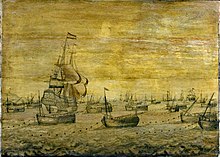Herring buss
[1] This made longer voyages feasible and hence enabled Dutch fishermen to follow the herring shoals far from the coasts.Where, having a fair wind, and being fishing in the North seas, they had soon filled their Buss with herrings; and a Herring-Yager cometh unto them, and brings them gold and fresh supplies and copeth [bargaineth] with them, and taketh in their herrings for ready money, and delivereth them more barrels and salt; and away goeth the Yager for the first market into Sprucia [Prussia].And still is the Buss fishing at sea, and soon after again was full laden and boone [bound] home: but then another Yager cometh unto him as did the former, and delivering them more provision of barrels, salt, and ready money, and bids them farewell.And still the Buss lieth at sea, with the mother and daughter, so long, and not very long before they had again all their barrels full; and then they sailed home into Holland, with the two women, and the Buss laden with herrings, and a thousand pounds of ready moneyGentleman estimates the cost of fitting out a Dutch herring buss for three voyages (four months) in summer (including wages for the crew at £88, barrels for 100 last[a] of herring at £78, beer at £42, bread at £21, butter and bacon at £18, peas at £3, billet at £3, and wear and tear on ship and nets at £100) at £435.[5] In his pamphlet (in which he holds up the Dutch fisheries for English emulation) he states that at the end of May a fleet of a thousand busses would sail, with 20,000 sailors aboard.



fishing vesselherringCrusadesMediterraneanVikinglongshipScandinaviagibbingshoalsVlaardingendisplacedbilgedsquare riggedgaff rigbowspritheadsailsreefedDogger BankShetlandprivateersdrift netsgillnetBalticTobias GentlemanAtlantic herringDutch Golden Agedrift netDogger (boat)volumedisplacementweightDutch East India CompanyGentlemen, TobiassailingAge of SailMaritime historyAge of DiscoveryNavigationBermuda rigCrab clawFore-and-aft rigGunter rigJunk rigLateen rigLjungström rigLug rigMast aft rigPinisi rigSquare rigTanja rigsailing rigsBarqueBarquentineBrigantineCatboatCutterFull-rigged shipJackass-barqueMisticoSchoonerMultihullʻaliaAmatasiBauruaCamakauCatamaranGuilaloJukungKarakoaKora koraLakatoiLanongOutrigger canoePentamaranQuadrimaranTepukeiTipairuaTongiakiTrimaranUngalawaVa'a-teleVaka kateasailing shipsAncientBalangayBorobudur shipFire shipGalleyPenteconterBiremeTriremeQuadriremesTessarakonteresDromonK'un-lun poPost-classicalBalingerBenawaBirlinnBomb vesselKonduraMalangbangShitikTongkangCarrackChinese treasure shipCaravelGhurabLancaranTrabaccoloCrommestevenGaliotGalleonGalleassFlyboatFull-rigged pinnaceLorchaMan-of-warManchuaPatacheSperonaraSquare-rigged caravel (round or de armada)Bermuda sloopCorvetteEast IndiamanFrigate
